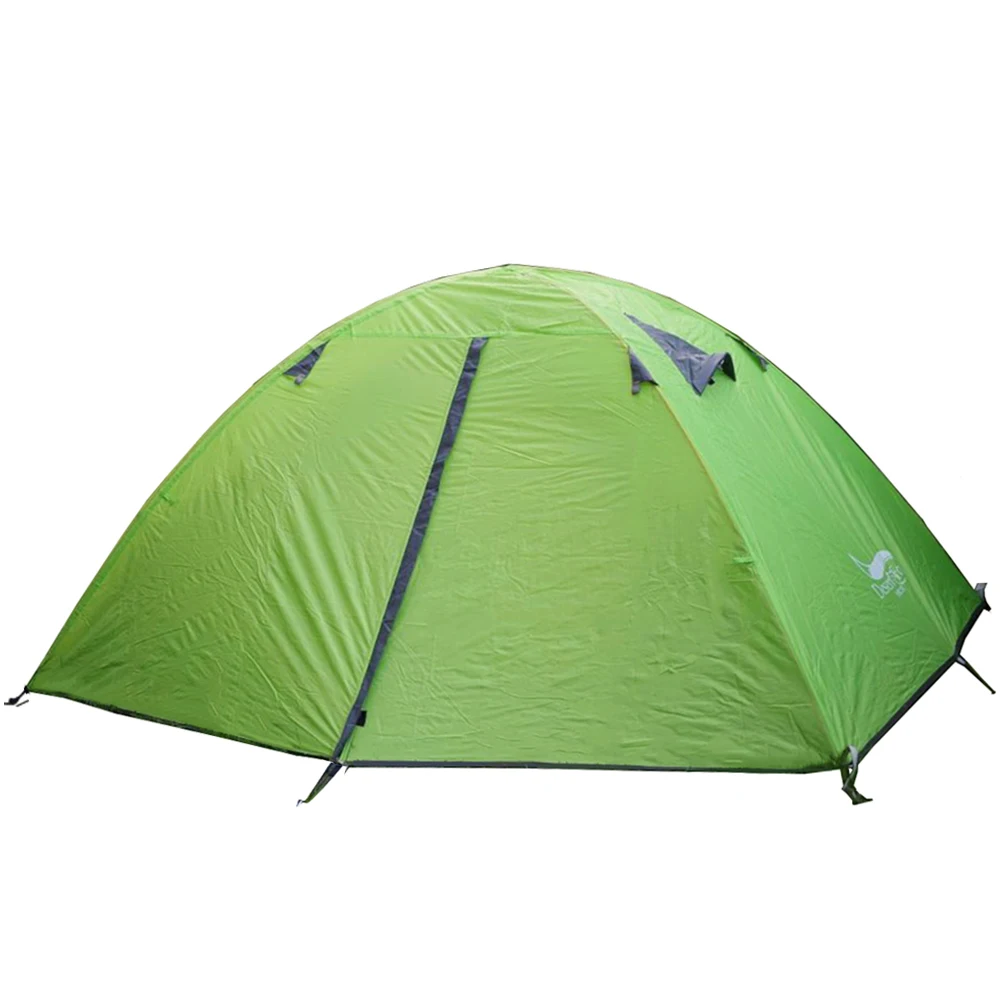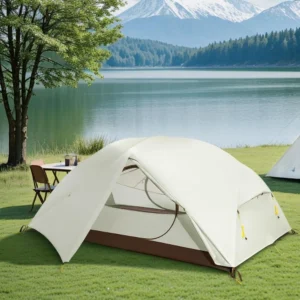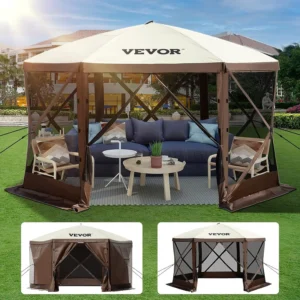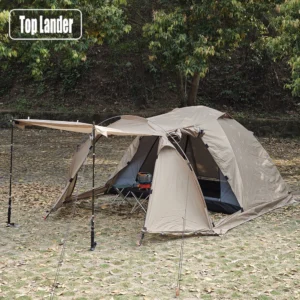Waterproof Backpacking Tent
Adventure on, rain or shine. Waterproof backpacking tents keep you dry and your gear safe without extra bulk, helping you pack light, stay comfortable, and explore more.

Showing all 2 results
Lightweight Backpacking Tent, Ultralight Backpacking Tent, Waterproof Backpacking Tent
$391.05 Select options This product has multiple variants. The options may be chosen on the product pageBackpacking Tent with Vestibule, Lightweight Backpacking Tent, Waterproof Backpacking Tent, Waterproof Camping Tent
Price range: $217.82 through $338.44 Select options This product has multiple variants. The options may be chosen on the product page
Showing all 2 results
Understanding Waterproof Backpacking Tents
When venturing into the backcountry, your shelter becomes your home. Waterproof backpacking tents are specialized shelters designed to protect adventurers from the elements while being light enough to carry over many miles. Unlike standard camping tents, these shelters use lighter materials, more specialized waterproofing technology, and feature compact designs that minimize weight without sacrificing protection.
Proper waterproofing isn’t just about staying dry—it’s about safety and comfort during multi-day adventures. Statistics show that unexpected rainfall affects nearly 30% of backpacking trips, and moisture intrusion can lead to hypothermia even in mild temperatures. A truly waterproof tent protects not just you but also your essential gear from becoming waterlogged and unusable.
At Explore Elements, we understand the delicate balance between waterproof protection and weight considerations. Every ounce matters when you’re carrying your home on your back, which is why our selection focuses on tents that achieve optimal weather protection without unnecessary bulk.
Essential Waterproof Technologies
Understanding waterproofing technology helps you make informed choices about your backcountry shelter. The most important measurement is the Hydrostatic Head (HH) rating, which indicates how much water pressure a fabric can withstand before leaking. For backpacking tents, look for:
- Floor ratings: 2000-3000mm minimum (higher for extreme conditions)
- Rainfly ratings: 1200-1500mm minimum for reliable protection
Common waterproof materials include:
- Ripstop nylon with silicone coating (silnylon) – lightweight with excellent tear resistance
- Polyester with polyurethane (PU) coating – less expensive but heavier
- Dyneema Composite Fabric (DCF) – ultralight with superior waterproofing but at premium cost
The difference between a 1500mm and 3000mm rating becomes apparent during sustained heavy rain. A 1500mm tent may begin to seep after hours of downpour, while 3000mm construction typically remains dry even in storm conditions.
Equally important are seam construction techniques. Factory-taped seams provide much better protection than those requiring user-applied seam sealer, creating waterproof barriers at the tent’s most vulnerable points.
Key Features of Quality Waterproof Tents
Beyond materials alone, specific design features determine a tent’s ability to keep water out:
- Full-coverage rainfly: Extends to or near the ground, preventing splash-back and wind-driven rain from entering
- Bathtub floor construction: Creates a waterproof tub with 3-5 inches of vertical waterproof material around the perimeter to prevent ground water seepage
- Vestibule design: Provides protected space for gear storage and a buffer zone between wet exterior and dry interior
- Strategic ventilation: Helps manage condensation without creating entry points for water
When severe weather hits, quality tents demonstrate their worth through multiple reinforced guy-out points that maintain structural integrity against wind and rain. In real-world conditions, these features mean the difference between a comfortably dry night and a miserable, soggy one.
Single-Wall vs. Double-Wall Construction
Waterproof backpacking tents typically feature one of two construction styles:
Single-wall tents:
– Combine the rainfly and tent body into a single layer
– Advantages: Lighter weight, faster setup, more compact
– Disadvantages: More condensation issues, often less ventilation
Double-wall tents:
– Feature a separate inner tent body and outer rainfly
– Advantages: Superior condensation management, versatility (can use just inner tent in dry weather)
– Disadvantages: Slightly heavier, more complex setup, larger packed size
Single-wall designs excel in alpine environments and ultralight applications where every ounce counts. Double-wall constructions generally perform better in humid conditions where condensation management becomes crucial for comfort.
Seasonality and Weather Protection
Waterproof tents are categorized by their intended seasonal use:
3-season tents:
– Designed for spring through fall conditions
– Feature more mesh for ventilation
– Waterproof ratings typically sufficient for standard rainfall
– Not engineered for snow loading or extreme winds
4-season tents (mountaineering):
– Built for year-round use including winter conditions
– Feature stronger pole structures and more robust materials
– Higher waterproof ratings to handle snow melt and severe storms
– Less ventilation to retain heat but better condensation management systems
The tradeoff between ultra-lightweight protection and expedition-grade durability becomes evident when weather turns severe. A summer-weight ultralight tent may struggle in unexpected early-season snow, while an expedition tent might be unnecessarily heavy for mild conditions.
Size and Capacity Considerations
Tent capacity affects both comfort and water management:
- 1-person tents: Minimal interior space means gear often needs vestibule storage, critical during rainfall
- 2-person tents: Most popular balance of space and weight, typically providing 28-35 square feet
- 3+ person tents: More interior volume but significantly heavier to carry
Vestibule space becomes particularly important during extended rain when cooking and gear organization must happen under shelter. The best waterproof backpacking tents provide adequate protected space without excessive weight.
Maintaining Waterproof Performance and Setup
Proper use and maintenance significantly extend the waterproof performance of your tent:
- Select elevated ground for tent setup to prevent pooling water
- Use a footprint to protect the floor from punctures and abrasion
- Clean tents with gentle soap only—harsh detergents can damage waterproof coatings
- Apply fresh DWR (Durable Water Repellent) treatment when water stops beading on fabric
- Always dry thoroughly before storage to prevent mildew damage to waterproof coatings
Signs that waterproofing is deteriorating include water absorption (rather than beading) on the rainfly and seams that begin to leak during rain. Address these issues promptly to maintain protection.
Popular Waterproof Materials Comparison
| Material | Weight | Durability | Water Resistance | Cost | Best For |
|---|---|---|---|---|---|
| Silicone-coated nylon | Low-Medium | Good | Very Good | Medium | Balance of weight/performance |
| PU-coated polyester | Medium-High | Very Good | Good | Lower | Durability, value |
| Dyneema Composite | Very Low | Excellent | Excellent | Very High | Ultralight expeditions |
The material choice significantly impacts tent performance. Silicone-coated nylon provides excellent waterproofing but requires careful handling, while polyester maintains consistent waterproofing even after UV exposure—an important consideration for extended trips.
Specialized Waterproofing for Extreme Conditions
For challenging environments, look for specialized features:
- Extended vestibules for gear management during prolonged storms
- Multiple guy-out points with reflective cordage for stability in high winds
- Reinforced stress points to prevent fabric tearing
- Snow skirts on mountaineering tents to prevent blowing snow entry
- Ventilation systems that function even when fully battened down
Explore Elements tests all our tents in real-world extreme conditions to ensure they perform when it matters most.
Common Questions About Waterproof Tents
Q: How can I tell if moisture is condensation or a leak?
A: Condensation forms evenly on interior surfaces, while leaks create distinct wet spots, often at seams or corners.
Q: How often should I reapply waterproofing?
A: When water stops beading on fabric—typically every 1-2 seasons depending on use.
Q: Are ultralight backpacking tents as waterproof as heavier models?
A: Quality ultralight tents can be equally waterproof but may use thinner materials that require more careful handling to maintain integrity.
Q: What should I expect in sustained heavy rain?
A: A properly set up quality tent should remain dry inside even during all-day rain, though condensation management becomes increasingly important.
Finding the perfect waterproof backpacking tent balances protection, weight, and your specific adventure needs. Explore Elements curates only tents that meet our rigorous standards for waterproofing performance, ensuring you stay dry and comfortable, wherever the trail leads.





